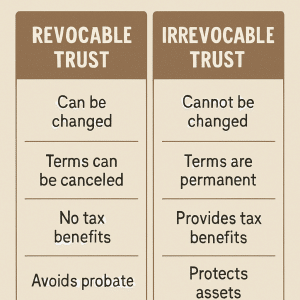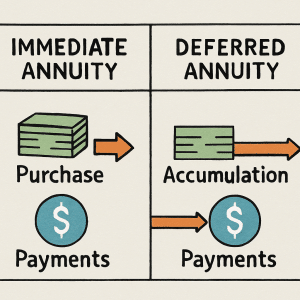What Are Annuity Income Riders?
Annuity income riders are optional add-ons you can attach to a fixed index annuity or variable annuity to secure guaranteed lifetime income. Think of income riders as a paycheck you can’t outlive—without giving up full ownership of your account. With an income rider, your benefit base grows by a stated rate or roll-up and later converts to guaranteed withdrawals for life, even if your account value goes to zero. Many consumers search for “income riderrs” and “annuity income riders” when comparing retirement income solutions because riders can turn protected savings into predictable paychecks.
How Income Riders Work
When you add an income rider, the insurer tracks two values:
- Account value: your real, cash value that earns interest or index-linked credits.
- Income benefit base: a separate figure used only to calculate future lifetime withdrawals.
During the deferral years, the income benefit base may earn a guaranteed roll-up rate or step-ups based on performance. When you “turn on” the rider, your lifetime payout is calculated using an age-based payout factor applied to the income base. The result: reliable income you can’t outlive, with options for single life or joint life for a spouse.
Pros and Cons of Income Riders
Benefits of annuity income riders:
- Lifetime income you can’t outlive, addressing longevity and sequence-of-returns risk.
- Flexibility to defer income until the timing is right.
- Optional features like inflation adjustments, joint benefits, and enhanced income for confinement or impairment in some products.
Considerations:
- Rider fees may apply annually and can reduce account value.
- Income riders add complexity; terms vary by carrier.
- The income benefit base is not a cash value—it’s for calculating income only.
Who Should Consider Income Riderrs
Income riderrs and annuity income riders may fit if:
- You want a guaranteed income floor without annuitizing.
- You plan to retire within 3–10 years and can benefit from the roll-up period.
- You’re coordinating with Social Security and desire predictable, supplemental income.
- You want spousal protection via joint lifetime payout options.
Choosing the Right Income Rider
- Match goals: Do you want maximum guaranteed income, inflation options, or lower fees?
- Compare: roll-up rates, step-up features, and payout factors by age.
- Review liquidity: free withdrawals and how excess withdrawals impact guarantees.
- Evaluate carriers: financial strength and rider fees, then integrate the rider into your broader plan.
Disclosure: Guarantees are subject to the claims-paying ability of the issuing insurer and specific contract terms. Review carrier materials before purchasing.
Case Study: Payments Immediately vs Defer 5 Years
Male, age 65, $100,000 premium. Comparing guaranteed lifetime income via annuity income riders: turn income on immediately vs. defer to age 70.
Summary
Annuity income riders can convert protected savings into guaranteed lifetime income. Using your actual carrier illustrations, we compare two paths for a 65-year-old male funding $100,000: start income now or wait until age 70. Deferring generally raises the first-year payout and cumulative guarantees, provided you can cover cash-flow needs during the deferral years.
Key Takeaways
- Waiting to age 70 increases the first-year guaranteed payout compared to starting at age 65.
- Across these real cases, cumulative guaranteed withdrawals to age 95 are higher when deferring to 70.
- Accumulation value is projected to deplete in the late 70s in both paths; lifetime income continues per rider guarantees.
Guaranteed Income Rider Comparison
Illustration-Based Results
| Scenario | Carrier & Product | Rider | First Guaranteed Income | Cumulative Withdrawals to Age 95 | Accumulation Value Depletion Age |
|---|---|---|---|---|---|
|
Start Income Now (Age 65)
Based on attached “begin immediately” illustration
|
F&G SecureIncome 7
Fidelity & Guaranty Life Insurance Company (A, A.M. Best)
|
EGMWB Rider | $7,840 | $243,040 | 77 |
|
Nationwide Peak 10 (Most States)
Nationwide Life & Annuity Insurance Company (A+, A.M. Best)
|
Bonus Income Rider (Single) | $7,813 | $242,188 | 77 | |
|
Power Select Plus Income
Corebridge Financial Inc. (A, A.M. Best)
|
Lifetime Income Plus Flex | $7,600 | $235,600 | 77 | |
|
Start Income at Age 70
Based on attached “begin at 70” illustration
|
Eagle Select Income Focus 7
Eagle Life Insurance Company (A, A.M. Best)
|
LIBR Option 1 | $12,240 | $318,240 | 77 |
|
Nationwide Peak 10 (Most States)
Nationwide Life & Annuity Insurance Company (A+, A.M. Best)
|
Bonus Income Rider (Single) | $11,988 | $311,675 | 77 | |
|
MarketEarly Income Index
EquiTrust Life Insurance Company (B++, A.M. Best)
|
MarketEarly Income Rider | $11,950 | $310,693 | 78 |
Sources: Carrier illustration “Guaranteed Scenario” tables (page 2 of each PDF). Figures shown are guaranteed as illustrated and subject to each contract’s terms, rider fees, state availability, and the insurer’s claims‑paying ability. Not a recommendation or contract. FOR AGENT/PRODUCER USE ONLY.
What This Means for You
If you need income immediately at 65, the strongest first-year payout in this set is F&G at $7,840, with Nationwide close behind. If you can defer to age 70, Eagle Life shows the highest first-year payout at $12,240 and the highest cumulative to age 95. Either way, lifetime income continues even if the accumulation value depletes in the late 70s, addressing longevity and sequence risk.
Simple Decision Guide
- Choose “Start Now” if you need guaranteed income immediately to cover essential expenses and value starting benefits over maximizing future payouts.
- Choose “Start at 70” if you can fund ages 65–69 from other sources and want higher lifetime income potential and stronger cumulative guarantees.
FAQ: Annuity Income Riders
What is an annuity income rider?
Do income riders cost extra?
Will income continue if account value reaches zero?
Is it better to start now or wait until age 70?
Disclosure: Figures above reflect guaranteed scenarios from carrier materials as of 10/20/2025 and may change. Guarantees rely on the issuing insurer’s claims-paying ability and contract terms. For Agent/Producer Use Only.

















